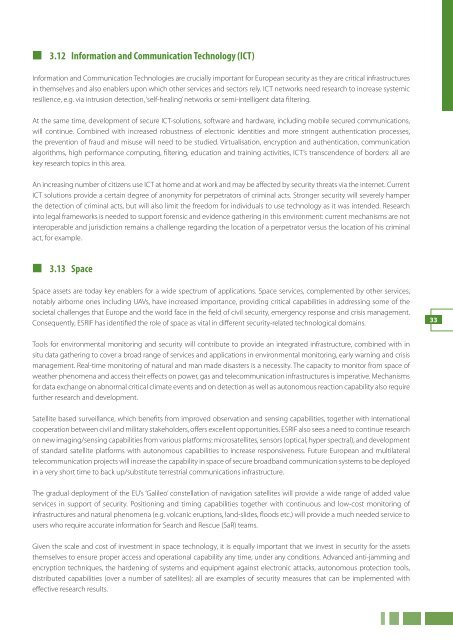I527-290 ESRIF Final Report (WEB).indd - European Commission
I527-290 ESRIF Final Report (WEB).indd - European Commission
I527-290 ESRIF Final Report (WEB).indd - European Commission
You also want an ePaper? Increase the reach of your titles
YUMPU automatically turns print PDFs into web optimized ePapers that Google loves.
3.12 Information and Communication Technology (ICT)<br />
Information and Communication Technologies are crucially important for <strong>European</strong> security as they are critical infrastructures<br />
in themselves and also enablers upon which other services and sectors rely. ICT networks need research to increase systemic<br />
resilience, e.g. via intrusion detection, ‘self-healing’ networks or semi-intelligent data fi ltering.<br />
At the same time, development of secure ICT-solutions, software and hardware, including mobile secured communications,<br />
will continue. Combined with increased robustness of electronic identities and more stringent authentication processes,<br />
the prevention of fraud and misuse will need to be studied. Virtualisation, encryption and authentication, communication<br />
algorithms, high performance computing, fi ltering, education and training activities, ICT’s transcendence of borders: all are<br />
key research topics in this area.<br />
An increasing number of citizens use ICT at home and at work and may be aff ected by security threats via the internet. Current<br />
ICT solutions provide a certain degree of anonymity for perpetrators of criminal acts. Stronger security will severely hamper<br />
the detection of criminal acts, but will also limit the freedom for individuals to use technology as it was intended. Research<br />
into legal frameworks is needed to support forensic and evidence gathering in this environment: current mechanisms are not<br />
interoperable and jurisdiction remains a challenge regarding the location of a perpetrator versus the location of his criminal<br />
act, for example.<br />
3.13 Space<br />
Space assets are today key enablers for a wide spectrum of applications. Space services, complemented by other services,<br />
notably airborne ones including UAVs, have increased importance, providing critical capabilities in addressing some of the<br />
societal challenges that Europe and the world face in the fi eld of civil security, emergency response and crisis management.<br />
Consequently, <strong>ESRIF</strong> has identifi ed the role of space as vital in diff erent security-related technological domains.<br />
Tools for environmental monitoring and security will contribute to provide an integrated infrastructure, combined with in<br />
situ data gathering to cover a broad range of services and applications in environmental monitoring, early warning and crisis<br />
management. Real-time monitoring of natural and man made disasters is a necessity. The capacity to monitor from space of<br />
weather phenomena and access their eff ects on power, gas and telecommunication infrastructures is imperative. Mechanisms<br />
for data exchange on abnormal critical climate events and on detection as well as autonomous reaction capability also require<br />
further research and development.<br />
Satellite based surveillance, which benefi ts from improved observation and sensing capabilities, together with international<br />
cooperation between civil and military stakeholders, off ers excellent opportunities. <strong>ESRIF</strong> also sees a need to continue research<br />
on new imaging/sensing capabilities from various platforms: microsatellites, sensors (optical, hyper spectral), and development<br />
of standard satellite platforms with autonomous capabilities to increase responsiveness. Future <strong>European</strong> and multilateral<br />
telecommunication projects will increase the capability in space of secure broadband communication systems to be deployed<br />
in a very short time to back up/substitute terrestrial communications infrastructure.<br />
The gradual deployment of the EU’s ‘Galileo’ constellation of navigation satellites will provide a wide range of added value<br />
services in support of security. Positioning and timing capabilities together with continuous and low-cost monitoring of<br />
infrastructures and natural phenomena (e.g. volcanic eruptions, land-slides, fl oods etc.) will provide a much needed service to<br />
users who require accurate information for Search and Rescue (SaR) teams.<br />
Given the scale and cost of investment in space technology, it is equally important that we invest in security for the assets<br />
themselves to ensure proper access and operational capability any time, under any conditions. Advanced anti-jamming and<br />
encryption techniques, the hardening of systems and equipment against electronic attacks, autonomous protection tools,<br />
distributed capabilities (over a number of satellites): all are examples of security measures that can be implemented with<br />
eff ective research results.<br />
33

















